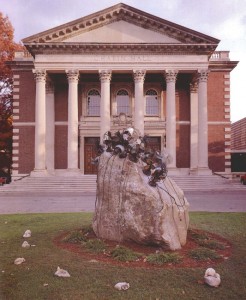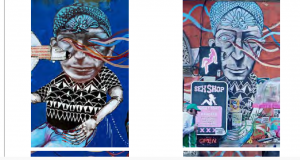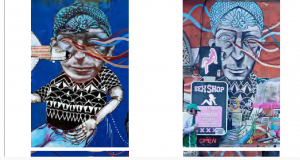McDonald’s recently prevailed on personal jurisdiction grounds in a closely-watched case in California about the use of street art as décor for restaurants in the United Kingdom, but the issue has quickly arisen again. As part of what the fast-food giant has clearly decided is a winning branding strategy, the chain’s use of graffiti from New York has now brought the threat of litigation from the so-called Bushwick Collective. Where any such lawsuit gets filed will have a great deal to do with what happens next.
McDonald's Beats Graffiti Copyright Claims in California, But Faces New Threat over New York Street Art
Topics: Joseph Tierney, Netherlands, Digital Millennium Copyright Act, Rime, California, specific jurisdiction, 17 U.S.C. § 1202, general jurisdiction, Moschino, personal jurisdiction, Graffiti, New York, Dashiell Snow, McDonald's, Street Art, Daimler AG v. Bauman, Virus, NDA, Don Rimx, Beau Stanton, Himbad, United Kingdom, Atomik, Bushwick Collective
Anish Kapoor in Versailles: Requiring Removal of Graffiti Turns Into Compelled Speech
Back in June, sculptor Anish Kapoor installed the sculpture Dirty Corner on the grounds of the famous palace there. Kapoor, who can’t seem to avoid public controversy over his work, saw the sculpture first become the object of debate with regard to its form itself, specifically, the suggestion that the shape of the large work was anatomical. Kapoor coyly fostered speculations about what it was meant to represent, but ultimately demurred that his “work has multiple interpretive possibilities." With recent vandalism and a court order that he remove the graffiti, however, the story has turned into one more about free expression and compelled speech. So far, it does not have a happy ending.
Topics: Rock Fan, Versailles, The Art Newspaper, Fabien Bouglé, Ku Klux Klan, Dirty Corner, Graffiti Art, France, Williams College, Fleur Pellerin, Nazis, Palace of Versailles, Confederate Flag, Richard Serra, Catherine Pégard, refugee crisis, Williams College Museum of Art, First Amendment, Yardbird Suite, Anish Kapoor, François Hollande, vandalism, anti-Semitic, Graffiti, Amherst College, Tilted Arc
10, 9, 8…the Biggest Art Law Report Stories of 2014 and a Look Ahead
As the ball teeters above Times Square, and the Glühwein begins to mull on the Art Law Report stove (don’t forget the cinnamon!), a gimmicky but apropos act of reflection is to look back at the biggest stories of 2014, both in art law generally and for yours truly and Sullivan & Worcester LLP. In highly subjective, unverifiable, and immediately criticizeable order, here they are. Thanks as always for reading, and best wishes for in interesting, prosperous New Year. If you agree, disagree, or otherwise, please continue to stay in touch and carry the conversation forward.
Topics: Comedy Central, Deaccession, Schwabinger Kunstfund, Charitable Foundations, National Gallery of Art, Knoedler, Cornelius Gurlitt, Blogs, authentication, authenticity, parody, William Corcoran, Moral Rights, Above the Law, Germany, George Washington University, Glühwein, Nazi-looted art, Gurlitt Collection, Norton Simon, Graffiti Art, Superior Court, Cy Pres, Washington DC, VARA, Detroit Institute of Arts, Bankruptcy, Corcoran College of Art + Design, Dumb Starbucks, Preemption, Asher Edelman, DIA, Restitution, Marei Von Saher, Artmentum GmbH, Bavaria, Sullivan & Worcester LLP, World War II, Copyright, Times Square, Art Fairs, Kunstmuseum Bern, Corcoran Gallery, Ninth Circuit Court of Appeals, Museums, Raubkunst, Detroit Bankruptcy, Fair Use, Münchner Kunstfund, Foreign Cultural Exchange Jurisdictional Immunity, Graffiti, Civil Forfeiture, Art Law Report
Graffiti Litigation Update: Settlements and Procedural Wrangling
Back in October, we surveyed some developments in lawsuits over public art and protection available under copyright law in graffiti art. There has been some movement, and other developments, in these cases.
Topics: Ahol Sniffs Glue, Zero Theorem, Digital Milennium Copyright Act, David Anasagasti, Zappos.com Inc., Monty Python, Sara Bareilles, 15 U.S.C. § 1125(a), London, Terry Giliam, the Lanham Act, DMCA, Jason 'Revok' Williams, 17 U.S.C. §1202 et seq., Public Art, Graffiti Art, Romania, Vogue, Nordstrom Inc., Chicago, Amazon.com Inc., unfair competition, Robert Cavalli, Victor 'Reyes' Chapa, Jeffrey 'Steel' Rubin, Copyright, Buenos Aires, Litigation, Ocean Grown, Wal-Mart, New York Magazine, Graffiti, California Business and Professions Code § 17200, Staff USA Inc.
Graffiti, Vandalism, and Public Expression: Public Art and its Uneasy Relationship with the Law
Recurring events involving public art have underscored the tension between that expression and the law. Banksy’s “residence” in New York last fall broached this subject, but this summer’s Brooklyn Bridge flag incident, and several new lawsuits asserting copyright in graffiti will test the bounds of what the law protects and what it permits. As Banksy says in one of his murals, "graffiti is a crime."
Topics: Burrow-Giles Lithographic Co. v. Sarony, Ahol Sniffs Glue, David Anasagasti, Steel, City as Canvas, Moral Rights, Argentina, Public Art, Graffiti Art, Philippa Loengard, Visual Artists Rights Act of 1990, Leonardo’s Last Supper, Columbia Law School’s Kernochan Center for Law Med, Chicago, Museum of the City of New York, VARA, Public Expression, Michael Bloomberg, American Eagle, Terry Gilliam, Banksy, 17 U.S.C. § 106A, Copyright, Buenos Aires, 5Pointz, Revok, Roberto Cavalli, vandalism, Reyes, Graffiti, The Atlantic, New York






